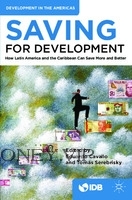
1 Saving for a
Sunny Day
Why should people—and economies—save? The typical answer usually
focuses on the need to protect against future shocks, to smooth con-
sumption during hard times, in short, to save for the proverbial rainy day.
This book approaches the question from a slightly different angle. While
saving to survive the bad times is important, saving to thrive in the good
times is what really counts. People must save so they can invest in their
own and their children’s health and education, live productive fulfilling
lives, and end their days in comfort and peace. Firms must save so they
can grow productive enterprises that employ more workers in better
jobs to produce quality goods for domestic and international markets.
Governments must save to build bridges, highways, and airports that
support a productive economy, to provide quality services such as edu-
cation, health, water, and sanitation to their citizens, and to assure their
senior citizens a dignified, worry-free retirement. In short, countries must
save for a sunny day—a time when everyone can bask in the benefits of
growth, prosperity, and well-being.
To have even a chance of reaching that sunny day, this book argues
that Latin America and the Caribbean must save more and save better. It
contends that saving in the region is too low and that the savings that do
exist can be used more efficiently to enhance growth and development.
The purpose of this book is to raise awareness about the urgent need to
promote more and better saving to address several of the region’s most
pressing issues including lackluster growth, low investment rates, and
the growing need to care for an aging population.
Why should economies care about how much they save? After all, if
economies can always borrow from abroad, then national saving rates
should not matter. However, borrowing from abroad may be more costly
and may raise the risk of crises. Foreign financial flows are fickle, and
history shows that they dry up just when they are needed most. Latin
America and the Caribbean is no stranger to the currency and financial
turmoil generated by external debt. Importing saving from abroad is far
from a perfect substitute to boosting saving at home.
Given the limits to external borrowing, countries that save more
also invest more. In other words, there is a positive association between
national saving and domestic investment (investment in the real econ-
omy, not purely financial investment). From a policy perspective, it is
useful to understand which drives which: whether higher saving leads to
more real investment or whether better investment opportunities lead to
increases in saving. This book argues that causality runs in both direc-
tions. Or more precisely, that Latin America and the Caribbean suffers
from two reinforcing problems: low saving supply and weak investment
demand. Solving these problems and breaking the vicious cycle between
them demands concerted and swift policy action to increase saving and
investment.
Savings: The Sum of its Parts
National saving is the sum of all the individual saving decisions of the
agents in the economy: households, firms, and government agencies.
While a macroeconomic analysis is instructive, in the end saving deci-
sions are made by individuals and reflect the information they have and
the many real-life considerations that may influence their behavior. To
fully understand the problem of saving, it is imperative to break down
and analyze how the savings generated by households, firms, and gov-
ernment agencies is aggregated and channeled to the economy.
The financial system is the middle man: it moves the resources from
people who save to those who need the resources to invest. Small and
inefficient financial systems, like those in Latin America and the Carib-
bean, jack up the costs for financial services, which in turn depress both
saving (by reducing effective returns to savers) and investment (by
increasing the cost of credit to borrowers). In such contexts, households
that lack access to good financial savings instruments may opt to save in
other ways—by accumulating cash or jewelry, by buying durable goods,
or by investing in the family firm— which may not be the most produc-
tive. These mechanisms reduce the collective efficiency with which the
existing savings are used. A good financial system not only mobilizes
savings but also pools them and allocates them efficiently to finance
the projects with the highest returns. If savings are not pooled within a




